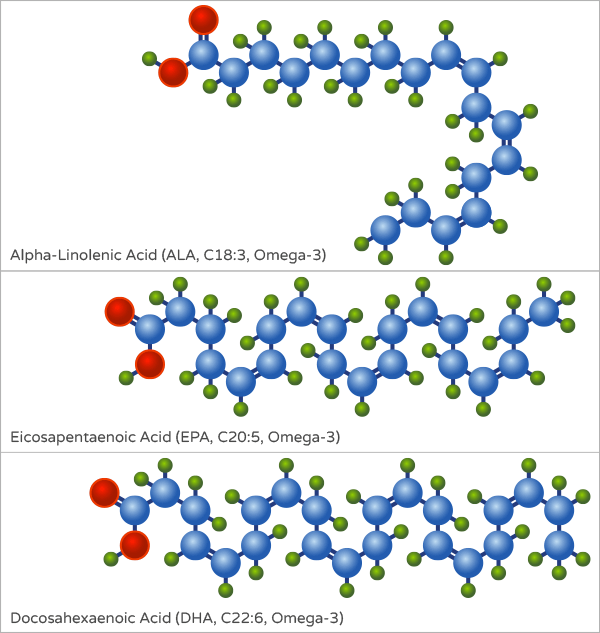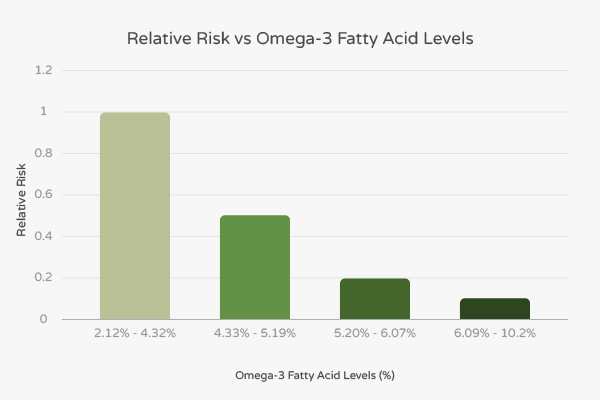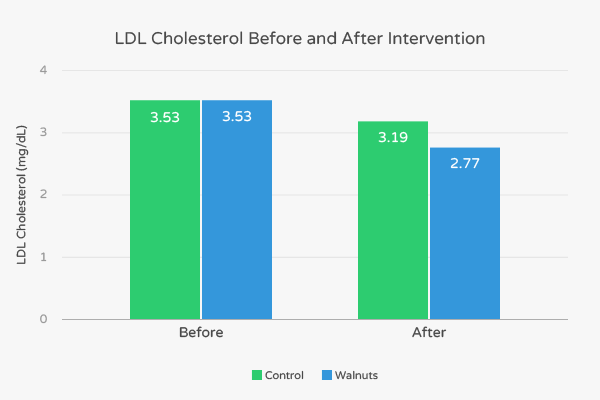Omega-3 fatty acids are a special type of fat molecule. As a triglyceride, they consist of a small compound called glycerol (C3H8O3) attached to three chains of carbon atoms called fatty acids. They are a polyunsaturated fat, which means that they contain more than one carbon-carbon double bonds. In contrast, monounsaturated fats contain only one carbon-carbon double bond while saturated fats contain no carbon-carbon double bonds.
Fatty acids generally have two ends: a carboxylic acid, which is designated as the beginning of the chain, and methyl, which is considered to be the end of the chain and denoted by the title omega. Omega-3 fatty acids are distinguished from other polyunsaturated fats by having one of their carbon-carbon double bond at the third carbon atom at the end of the carbon chain.
In human nutrition, omega-3 fatty acids are found in three varieties. The first is alpha-linolenic acid (ALA), which is the shortest kind and is 18 carbon atoms in length and contains 3 carbon-carbon double bonds. It is most commonly found in vegetable products such as soybeans, walnuts, and canola oil. [1]
The other two sources are eicosapentaenoic acid (EPA) and docosahexaenoic acid (DHA). EPA is of medium length and contains 20 carbons and 5 carbon-carbon double bonds while DHA is the longest and contains 22 carbons and 6 carbon-carbon double bonds.
Both DHA and EPA are only found in the oils of marine organisms including fatty fish such as sardines, mackerel, and salmon, fish oil supplements derived from the skins of these fish, and other aquatic organisms such as marine algae or phytoplankton. [2]

Why are Omega 3’s Important?
Omega-3 fatty acids have many important functions in the body. They are a crucial component of cell membranes and regulate the function of receptors in these membranes. [2] Additionally, they serve as the basis of many hormones. [3]
They also regulate inflammation, blood clotting, and stimulate relaxation and contraction of artery walls. Finally, EPA and DHA are precursors to molecules that help and prevent several metabolic diseases. [3]
Is Consuming a Diet Rich in Omega-3 Fatty Acids Helpful? Looking at the Epidemiological Research
It’s true that omega-3 fatty acids have a lot of important functions in the body. But do they actually provide any unique clinical benefits?
Abundant research shows that a diet high in omega-3 fatty acids has cardioprotective benefits. As early as the 1940s, researchers have described a very low prevalence of cardiovascular diseases in Greenland Eskimos, who traditionally consume a diet high in omega-3 fatty acids from marine sources including fatty fish, seal, and whale.
Epidemiological and randomized clinical trials have shown that omega-3 fatty acids can reduce:
- The incidence of arrhythmias [4]
- The incidence of heart failure [4]
- Reduce the rate of myocardial infarction (also known as heart attack) [5]
- Lower triglycerides [4]
- Lower LDL cholesterol [4]
- Decrease Blood Pressure [4]
- Risk of sudden cardiac death (SCD) [4]
- Has anti-inflammatory effects [4]

Risk of sudden cardiac and baseline blood levels of omega-3 fatty acids as a percentage of total serum fatty acids. Figure from; Data from Albert et al.
Many researchers surmise that these benefits are a result of DHA and EPA enrichment of phospholipids found in cellular membranes that ultimately lower inflammation. ALA eaten is usually consumed to DHA or EPA before it is used.
As a result of these findings, the American heart association issued an official statement in 2002 confirming the strong research behind the regular consumption of omega-3 fatty acids and strong cardiovascular health. [6]
According to research compiled by the University of Maryland Research Center, regular consumption of omega-3 fatty acids may confer the following clinical benefits:
- Research supports other health benefits of regular omega-3 fatty acids consumption such as:
- Reducing the symptoms of rheumatoid arthritis (RA)
- Lowering the incidence of prostate cancer
- Reducing the risk of women developing breast cancer
- Alleviating the symptoms associated with systemic lupus (SLE)
- Improving bone strength by increasing calcium levels in the body.
- Relieving symptoms associated with Depression
- Learning ability in boys suffering from attention deficit hyperactivity disorder (ADHD)
- Cognitive decline associated with aging-related diseases such as dementia and Alzheimer’s Disease
- Reducing sun sensitivity in people with the skin disorder “dermatitis”
- Symptoms associated with asthma
- The incidence of macular degeneration, a serious age-related eye condition
- Pain associated with menstruation
- The incidence of colon cancer
However, research into the clinical benefits in each of these areas isn’t as strong. More rigorous research needs to be done to establish the impact that regular consumption of omega-3 fatty acids in each of these conditions.
How Do We Get Omega-3 Fatty Acids in Our Diet?
Omega-3 fatty acids are essential to humans. This means that they are not produced by the body and must be consumed through supplement or diet. Despite their importance, most Americans don’t get sufficient amounts of omega-3 fatty acids in their diets.
In fact, dietary intake of omega-3 fatty acids has declined by 80% in the last 100 years. [7]
According to the food composition database by the US Food and Drug Administration, the most abundant foods in omega-3 fatty acids per 100-gram serving are as follows:
- Flaxseed oil (53304 mg)
- Salmon oil (35311 mg)
- Sardine oil (24093 mg)
- Flaxseed Seeds (22813 mg)
- Chia Seeds (17552 mg)
- Walnuts (9079 mg)
- Low Euric Acid canola oil (9138 mg)
It is important to note that ALA, which is the form of omega-3 fatty acids found in vegetarian sources such as walnuts and chia seeds, must be converted to EPA or DHA in the body, which is more plentiful in marine sources such as fatty fish and sardine. This conversion is pretty inefficient- only about 4-9% of ALA will be converted to DHA and only 8-21% of ALA will convert to EPA. [8]
Thus, it is important to make sure that you integrate a reasonable amount of sources in fatty fish to get the oil you need. According to research, target EPA + DHA consumption should be at least 500 mg/day for people without a history of cardiovascular illness and at least 800 mg to 1,000 mg per day for individuals who have a history of heart failure and/or coronary heart disease. [6]
That being said, ALA is still important and abundant research suggests that regular consumption of foods high in ALA benefits cardiovascular health. [9] However, research on the clinical impacts of ALA supplements is not strong. [10] Thus, the American Heart Association states that:
Evidence from prospective secondary prevention studies suggests that EPA & DHA supplementation ranging from 0.5 to 1.8 g/d (either as fatty fish or supplements) significantly reduces subsequent cardiac and all-cause mortality. For alpha-linolenic acid, total intakes of 1.5 to 3 g/d seem to be beneficial. [6]
The Benefits of Omega-3 Fatty Acid Rich Foods
Biochemistry and clinical theory are crucial in establishing the benefits of a compound in our diets. However, how can we apply that research to the ketogenic diet?
Below we document three of the most common foods abundant in omega-3 fatty acids- fatty fish, walnuts, and canola oil- and show the research examining the unique benefits of adding each to your ketogenic diet.
Fatty Fish
Fatty fish such as mackerel, salmon, sardines, and tuna, are the best natural source of high-quality omega-3 fatty acids in the form of DHA and EPA. So what does the research say on the benefits of their clinical consumption?
In an epidemiological analysis conducted by Zheng et al. in 2012, researchers observed a fairly strong, inverse the association between fatty fish consumption and cardiovascular health diseases in 315,812 subjects. Individuals who consumed one serving of fatty fish per week had a 16% lower risk of developing cardiovascular diseases than those who didn’t eat fatty fish at all. [11]
Additionally, individuals that consumed 2-4 servings per week had 21% lower risk of developing cardiovascular diseases than those that didn’t eat fatty fish. [11]

The researchers couldn’t determine any unique effects of high consumption (more than 5 servings per week). [11] Because of these results, the researchers concluded that eating fatty at least twice a week had a positive influence on cardiovascular health. [11]
The cardiovascular benefits of fatty fish are supported by several other large-scaled epidemiological studies involving a collective total over 1 million subjects. [12, 13, 14, 15]
Another large-scaled epidemiological study suggests that fatty fish consumption may slightly reduce the risk of developing clinical complications that impair blood circulation to the brain called cerebrovascular diseases. Examples include cerebrovascular accidents (CVA), also known as strokes, and vascular dementia.
In their assessment, researchers examined data from 26 prospective cohort studies and 12 randomized intervention trials that included 794,000 total subjects. Overall, about 34,817 subjects developed a cerebrovascular complication. They discovered that individuals that ate at least 2-4 servings of fatty fish week had a 6% lower chance of developing cerebrovascular diseases compared to individuals that ate one serving or less of fatty fish per week. [16]
Additionally, those that ate fatty fish over five times per week had a 12% lower risk of developing CVA compared to individuals that ate one or fewer servings of fatty fish per week. [16] The researchers were unable to indicate whether or not the omega-3 fatty acids or some other compound in the fatty fish led to the observed reduction.
A lot of randomized controlled trials have been conducted on fish oil supplements, pills filled with oil from the skin of fatty fish that usually contain about 500-1000 mg of omega-3 fatty acids. In the past ten years, fish oil has become one of the most popular supplements in the United States. They annually generate $1.2 billion in sales, according to Nutrition Business Journal.
Research from the past ten years suggests that regularly consuming fish oil supplements may decrease levels of triglycerides, a fat molecule in the blood and fatty tissue that stores energy for later use. While a moderate level is critical for proper cellular function, high levels of triglycerides can increase your risk of a variety of cardiovascular diseases. [17, 18]
In a recent meta-analysis of 68 studies, clinical researchers assessed the effect that daily consumption of fewer than 7 grams of fish oil had on triglyceride levels in human subjects. The studies had an average of 41 subjects and had a collective total of 2,800 subjects. The duration of the studies was from 2 weeks to 18 weeks and lasted an average of 8 weeks.
Thirty-six of these studies were a randomized crossover (36) and twenty-six were parallel-controlled, meaning that they were all high-quality, clinical intervention studies. All subjects were relatively healthy and free of cardiovascular diseases, though some had high levels of triglycerides. The average intake of fish oil was 3-4 grams.
When analyzing the data, scientists noted that daily consumption of fish oil supplements resulted in an average decrease of 25% in triglyceride concentration in healthy subjects. [19] This decrease was more pronounced in subjects that had clinically high levels of triglycerides (>200 mg/dl) after supplementation. [19] As a result of these findings, the authors stated that:
it is clear that practical doses of n-3 fatty acids have a significant and probably clinically important effect on serum triglyceride concentrations, especially in patients with elevated levels of triglycerides. [19]
It is important to note that this study found a small but significant increase in LDL cholesterol (about 5-10%) and HDL cholesterol (about 1-3%). [19] Some research has indicated that increased LDL cholesterol concentration is associated with an increased risk of cardiovascular disease.
However, strong research suggests that LDL particle count and VLDL count are stronger indicators of cardiovascular diseases
(See “The Ketogenic Diet and Cholesterol” blog for a complete discussion.) Additionally, this increase is small overall.
Additionally, dieticians and doctors also recommend eating 2 or more servings of fatty fish per week instead of daily fish oil supplementation. [6] This is because omega-3 fatty acids are better absorbed by the body. [6] Additionally, eating the whole fish also provides supplementary compounds and nutrients that work synergistically with DPA and ELA. That being said, if you don’t like the taste of fatty fish, fish oil supplements
Recommendations: Strong research shows an association between fatty fish consumption and improved cardiovascular health. Isolated studies on DPA and ELA show that fish oil supplements are also a viable way of lowering triglycerides and thus improving heart health. That being said, dieticians recommend consuming fatty fish 2-3 times a week instead of daily fish oil supplementation due to other beneficial compounds that work with the omega-3 fatty acids in the fish.
Walnuts
Walnuts are a nut from any tree of the Juglans genus. The most commonly eaten nut is the Persian or English walnut, Juglans regia. Technically, a walnut is a drupe or drupaceous nut (like a coconut), not a true botanical nut. Nonetheless, walnuts share many common characteristics with other tree nuts.
Walnuts have an interesting chemical composition compared to other tree nuts. According to the US Department of Agriculture’s food composition database, 100 grams of walnuts contain 654 calories, 65.2 grams of fat, 15.2 grams of protein, and 6.7 grams of dietary fiber.
Most nuts are high in monounsaturated fatty acids, while walnuts are largely composed of polyunsaturated fatty acids (47.2 g, or about 72.4% of fat).

They are particularly abundant in alpha-linolenic acid (ALA), containing 9.1 grams per 100 grams of weight. This makes them one of the best natural sources of omega-3 fatty acids.
Recall that ALA is considered to be a lower quality source of omega-3 fatty acids because it must be converted to the longer DHA molecule before it can be utilized by the body. That being said, does eating walnuts still have a positive impact on human health?
A meta-analysis from 2009 suggests that walnuts are effective in maintaining optimal function of cardiovascular health. In it, researchers collected data from 13 randomized clinical control studies that included a total of 365 subjects. Intervention diets lasted from 4 to 24 weeks with walnuts supplying 10% to 24% of total calories.
Subjects who consumed a diet with walnuts experienced an average reduction in the total cholesterol concentration of 10.3 mg/dL, representing 4.9% decrease. Additionally, they had an average decrease in LDL cholesterol of 9.2 mg/dL, representing a 6.7% decline. [20] In contrast, subjects that didn’t eat walnuts experienced no changes in total and LDL cholesterol.
There were no significant differences in the change of HDL cholesterol, triglycerides, and body mass during the intervention in both the walnut and control groups. Because of these varied findings, researchers stated that “overall, high-walnut-enriched diets significantly decreased total and LDL cholesterol for the duration of the short-term trials.” [20]
In another study from 2009 lasting 4 weeks, a group of researchers was interested in comparing the impacts of walnuts and fatty fish on heart-healthy. They recruited 25 adults (14 men and 11 women) with high levels of cholesterol and triglycerides and split them into three different groups. The subjects ranged in age from 23 years to 65 years.
They also were relatively healthy, had normal to borderline levels of blood lipids such as triglycerides, LDL cholesterol, and total cholesterol, had no history of metabolic or chronic diseases, and didn’t consume any medication or supplements known to affect blood lipids. All subjects who ate nuts or fish more than twice per week were excluded, as well as those who drank caffeinated beverages and alcohol twice a week.
In the subjects evenly distributed the subjects into three groups that ate a certain dietary intervention. The first group of consumed a control diet that contained no walnuts or fish. The second group consumed a diet including 113 grams of salmon twice per week.
The third group ate a diet that included a daily consumption of 42.5 g of walnuts 6 days per week. All three diets were isocaloric, meaning that they were equal in the number of calories. Additionally, they had approximately the same percentage of calories from protein (15%), carbohydrates (60%), and fats (30%).
Before the study, the average total cholesterol was 5.41 mmol/L, the average LDL cholesterol was 3.53 mmol/L, and the average triglycerides were 1.25 mmol/L. [21] The researchers assumed that the lipid levels in these subjects had statistically insignificant differences. During the trial, TC in subjects that consumed walnuts decreased 0.54 mmol/L to 4.87 mmol/L. [21] This represents a 10% decrease. TC in subjects eating the control diet decreased by 0.27 mmol/L to 5.14 mmol/L, equivalent to a 5% decrease. [21]
In contrast, TC in subjects that consumed the control diet decreased to 5.33. This change is insignificant and less than that observed in both the walnut and control group. [21] The scientists discovered that mean LDL in subjects that ate walnuts decreased by 21.5% to 2.77 mmol/L. [21] Average LDL in the control group decreased by 9.5% to 5.14 mmol/L and insignificantly in the group eating fatty fish. [21] According to the authors “the walnut diet showed a 5.4% and 9.3% decrease in total cholesterol and LDL cholesterol compared with the control diet.” [21]
Thus, these findings suggest that walnuts are effective in lowering total cholesterol especially compared to consumption of fatty fish. Additionally, subjects who consumed walnuts experienced the greatest optimization in the total cholesterol: HDL cholesterol ratio and LDL cholesterol: HDL cholesterol ratio. [21]

People who ate walnuts also experienced a moderate decrease in concentration of triglycerides, though this decrease was more pronounced in those who consumed fatty fish. This is consistent with the previous studies examining fatty fish, fish oil supplements, and walnuts.
As a result of these findings, the researchers stated that “including walnuts and fatty fish in a healthy diet lowered serum cholesterol and triglyceride concentrations, respectively, which affects CHD risk favorably.” [21]
Key Takeaways: Regular consumption of substantially walnuts lower heart-unhealthy LDL cholesterol and total cholesterol. Walnuts have little to no impact on levels of triglycerides and HDL cholesterol Consider eating fatty fish, marine oil, and fish oil supplements if you want to lower triglycerides.
Canola Oil
Canola oil was produced in 1970s by scientists in Canada. It is produced from a genetically modified version of the rapeseed plant. Canola oil is composed of 7% saturated fats, 63% monounsaturated fats, and 28% polyunsaturated fat.
Canola is oil is very high in the omega-3 fatty acid alpha-linolenic acid (ALA). In fact, flaxseed oil is the only oil with a higher amount of ALA.
Canola oil consumption is now very widespread in Canada, the United States, and beyond. In 2011, 38 million metric tons of canola oil were produced worldwide. It is the third most commonly consumed oil globally and second in the United States.

Because canola oil is produced from a genetically modified source, some diet experts have denounced it as unhealthy. However, what does the science say?
Even though canola oil is not natural, research indicates that is relatively healthy. In 2013, scientists conducted a meta-analysis of 31 randomized clinical studies that compared canola oil with saturated fats. In it they discovered that swapping canola oil for saturated fats can lower LDL cholesterol and total cholesterol.
These studies showed that substituting oils high in saturated fats with canola oil reduces LDL-C levels from a range of 11.1% to 25.2% with an average of 17%. When compared to diets rich in saturated fats, subjects who consumed a calorically-equivalent amount of canola oil had a decrease in total cholesterol ranging from 3.3% to 21.7%.
While this range is broad, it was impacted partially by factors such as study duration and suggests that sustained use of canola oil instead of oils high in saturated fats confers optimization of total cholesterol. When compared to diets high in saturated fats, canola oil does not seem to affect triglycerides or HDL cholesterol. Canola oil’s impact on lipid profile when compared to other oils high in unsaturated fats (such as olive oil) is mixed and inconclusive.
Because of these findings, the authors of the study stated that “Canola oil can now be regarded as one of the healthiest edible vegetable oils in terms of its biological functions and its ability to aid in reducing disease-related risk factors and improving health.”
Due to this compelling research, the FDA has stated that “…replacing a similar amount of saturated fat in the diet with canola oil without increasing calories” is a heart-healthy decision. Thus, if you are frequently using unhealthy oils low in omega-3 fatty acids such as soybean oil or lard, consider using canola oil (without adding more calories). Because of the credible research, the FDA also supports moderate use of canola oil stating that “…replacing a similar amount of saturated fat in the diet without increasing calories” is a smart choice.
How you can use canola oil: This oil plentiful in omega-3 fatty acids is very versatile and can be used to bake, fry, or cook anything. It can also be utilized to prepare dips, dressing, and other liquid-based foods.
Key Takeaways: Canola oil is a common, cheap, and versatile substitute for other oils high saturated fatty acids. Evidence supports that it can optimize your lipid profile by lowering total cholesterol while keeping HDL cholesterol levels healthy. However, unlike some of other oils we examine, it is not likely to reduce your levels of triglycerides.
Putting It All Together
Omega-3 fatty acids are a special type of fat molecule that are essential to many aspects of human health. In our diets, omega-3 fatty acids are found in three varieties: alpha-linolenic acid (ALA), eicosapentaenoic acid (EPA), and docosahexaenoic acid (DHA).
ALA is commonly found in vegetable products such as soybeans, walnuts, and canola oil, while DHA and EPA are more plentiful in marine sources such as fatty fish and sardines. All three are beneficial for heart health, reducing inflammation and pain, and decreasing the incidence of cancer.
ALA, however, must be converted into DHA and EPA in the body before providing these benefits. The only problem with this is that the conversion process is inefficient. This is partly why many dieticians and doctors recommend eating 2 or more servings of fatty fish per week.
Fish oil supplements are another good source of DHA and EPA. However, they aren’t even close to being as healthy and as absorbable as fatty fish.
If you are not a fan of fish, you can get more omega 3 fatty acids (from ALA) by adding walnuts, canola oil, and flaxseeds into your diet.
Walnuts are particularly abundant in ALA, making them one of the best natural sources of omega-3 fatty acids. Canola oil and flaxseeds are also great sources of ALA that are easy to add to the diet. All three (walnuts, canola oil, and flax seeds) improve heart health by optimizing cholesterol levels.
To get the benefits of omega-3 fatty acids, the ideal dose is 0.5 to 1.8 grams per day of EPA + DHA. (Adding in 1.5 to 3 grams per day of ALA seems to be beneficial as well.)
Some of the Best Ways to Get Your Daily Dose of Omega 3s
1. Eat two or more servings of fatty fish, like sardines and salmon, every week.
Not sure how to get more fatty fish in your diet? Try some of these delicious recipes to get you started:
2. Use canola oil for cooking and baking.
To maintain the positive health effects of canola oil, do not expose it to temperatures hotter than 400 degrees Fahrenheit (200 degrees Celsius). Cooking at such a high-temperature will cause the omega 3s (and the other polyunsaturated fats in the oil) to become deleterious to your health.
Canola oil can be substituted for other oils at a one to one ratio (e.g., one tablespoon of canola oil for each tablespoon of oil).
3. Add freshly ground flax seeds to your meals.
You can even make your own flax seed nut butter by blending flax seeds together with your favorite nut and mixing in melted coconut oil. Add some stevia, cinnamon, and salt to it, and you will have a delicious keto-friendly snack that is packed with ALA.
4. Eat a handful of walnuts as a snack (or bake with them).
Try our zucchini bread to get a delicious dose of walnuts:
5. Combine them all together into one meal.
For example, you make the Low Carb Walnut Crusted Salmon for your next meal. Simply substitute in canola oil for olive oil and sprinkle some flax seed powder on top. Enjoy!
Sources
- Rakel D. Rakel Integrative Medicine, 3rd ed. Philadelphia, PA: Saunders; 2012;86.
- Kidd, Parris M. “Omega-3 DHA and EPA for cognition, behavior, and mood: clinical findings and structural-functional synergies with cell membrane phospholipids.” Alternative medicine review 12.3 (2007): 207.
- Swanson, Danielle, Robert Block, and Shaker A. Mousa. “Omega-3 fatty acids EPA and DHA: health benefits throughout life.” Advances in Nutrition: An International Review Journal 3.1 (2012): 1-7.
- Lavie, Carl J., et al. “Omega-3 polyunsaturated fatty acids and cardiovascular diseases.” Journal of the American College of Cardiology 54.7 (2009): 585-594.
- Albert, Christine M., et al. “Blood levels of long-chain n–3 fatty acids and the risk of sudden death.” New England Journal of Medicine 346.15 (2002): 1113-1118.
- Kris-Etherton, Penny M., William S. Harris, and Lawrence J. Appel. “Fish consumption, fish oil, omega-3 fatty acids, and cardiovascular disease.” circulation 106.21 (2002): 2747-2757.
- Schwalfenberg, Gerry. “Omega-3 fatty acids: their beneficial role in cardiovascular health.” Canadian family physician 52.6 (2006): 734-740.
- Goyens, Petra LL, et al. “Conversion of α-linolenic acid in humans is influenced by the absolute amounts of α-linolenic acid and linoleic acid in the diet and not by their ratio.” The American journal of clinical nutrition 84.1 (2006): 44-53.
- Pan, An, et al. “α-Linolenic acid and risk of cardiovascular disease: a systematic review and meta-analysis.” The American journal of clinical nutrition96.6 (2012): 1262-1273.
- Geleijnse, Johanna M., Janette de Goede, and Ingeborg A. Brouwer. “Alpha-linolenic acid: is it essential to cardiovascular health?” Current atherosclerosis reports 12.6 (2010): 359-367.
- Zheng, Jusheng, et al. “Fish consumption and CHD mortality: an updated meta-analysis of seventeen cohort studies.” Public health nutrition 15.04 (2012): 725-737.
- Djoussé, Luc, et al. “Fish consumption, omega-3 fatty acids and risk of heart failure: a meta-analysis.” Clinical Nutrition 31.6 (2012): 846-853.
- Li, Y. H., et al. “Fish consumption and incidence of heart failure: a meta-analysis of prospective cohort studies.” Chinese medical journal 126.5 (2013): 942-948.
- Xun, P., et al. “Fish consumption and risk of stroke and its subtypes: accumulative evidence from a meta-analysis of prospective cohort studies.”European journal of clinical nutrition 66.11 (2012): 1199-1207.
- Yinko, Sylvie SL Leung, et al. “Fish consumption and acute coronary syndrome: a meta-analysis.” The American journal of medicine 127.9 (2014): 848-857.
- Chowdhury, Rajiv, et al. “Association between fish consumption, long chain omega 3 fatty acids, and risk of cerebrovascular disease: systematic review and meta-analysis.” Bmj 345 (2012): e6698.
- Hokanson, John E., and Melissa A. Austin. “Plasma triglyceride level is a risk factor for cardiovascular disease independent of high-density lipoprotein cholesterol level: a metaanalysis of population-based prospective studies.”Journal of cardiovascular risk 3.2 (1996): 213-219.
- Miller, Michael, et al. “Triglycerides and cardiovascular disease a scientific statement from the American Heart Association.” Circulation 123.20 (2011): 2292-2333.
- Harris, William S. “n-3 fatty acids and serum lipoproteins: human studies.” The American Journal of Clinical Nutrition 65.5 (1997): 1645S-1654S.
- Banel, Deirdre K., and Frank B. Hu. “Effects of walnut consumption on blood lipids and other cardiovascular risk factors: a meta-analysis and systematic review.” The American journal of clinical nutrition 90.1 (2009): 56-63.
- Rajaram, Sujatha, et al. “Walnuts and fatty fish influence different serum lipid fractions in normal to mildly hyperlipidemic individuals: a randomized controlled study.” The American journal of clinical nutrition 89.5 (2009): 1657S-1663S.